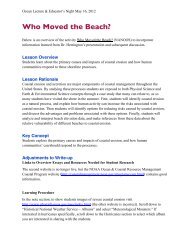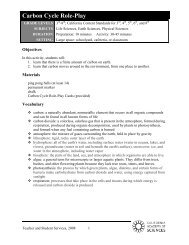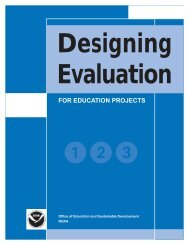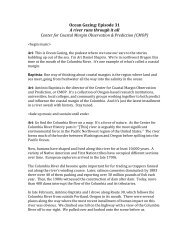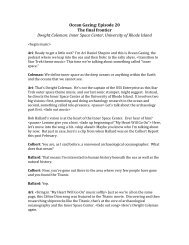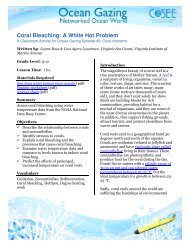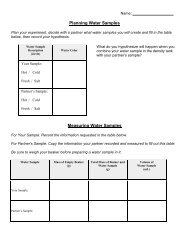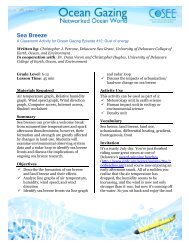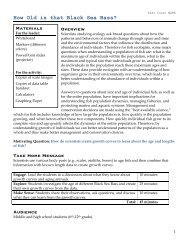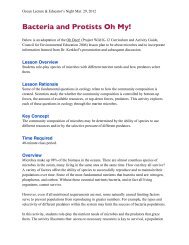Create successful ePaper yourself
Turn your PDF publications into a flip-book with our unique Google optimized e-Paper software.
Oceanographic Institution. Cook got her principal’s approval to participate. She found asubstitute teacher. But all this turned out to be the easy part.Cook: Be<strong>for</strong>e I left, I was really, really worried. I knew I would love the science. I mean I didn’t worryabout that. I was worried that I would be on that ship, and want to get off. I began to view it kind oflike a prison. But I’m kind of a person that if I’m afraid of something, then I’m just gonna go ahead andmake myself go through with it because I want to conquer that. But it didn’t take long after I was on theship and we were out to sea to realize that I never, ever felt like it was a prison at all. When you can’tsee any land <strong>for</strong> three weeks, it’s kind of liberating to just look at sky and water.Ari: And every day, Cook wrote a blog with stories and pictures <strong>for</strong> her students. She toldthem about how the science team was studying the Earth’s climate by using buoys anddrifters and probes to measure the ocean and the atmosphere. Her students emailed herback. And Cook was sure to let them k<strong>now</strong> when the buoy they’d adopted as a class wasreleased into the ocean to track the temperature and pressure of a particular current. It wasthis buoy more than anything else that caused her students’ interest to skyrocket.Cook: They signed these stickers, and then I took the stickers with me. And when I got to the ship and tothe little buoy, I put all their stickers on. Then I took pictures, and I posted them on the Internet. Theinterest in ocean currents quadrupled among my students because of that. And so they knew: that wastheir adopted buoy.Ari: I was reading your reflections on your Teacher at Sea experience, and at one point you say that eventhough the Teacher at Sea cruise took place a few years ago, it continues to be THE potent <strong>for</strong>ce in myapproach to teaching my students about oceanic and atmospheric sciences today. I’m just wondering,why?Cook: Because it’s so personal. And I think if you can make it more personal <strong>for</strong> the teacher and thestudents, they’re going to remember it. I’ve talked to those students that I had five years ago. And one ofthem, I saw him a couple of weeks ago. And he was talking about his graduation night. He wore hisNOAA pin on his graduation gown. So to me, it made a great impact on them. It’s so personal to me,and I learned so much. I mean, I had read about research but <strong>now</strong> I k<strong>now</strong> about it. And I’ve participatedin it.Ari: At Ahlf Junior High, Cook’s current students agree.Brett Blasco is one. He’s in the eighth grade. Be<strong>for</strong>e moving to Arkansas, he grew up onthe ocean in Washington state.Blasco: I enjoy the ocean. In the summer, cause my dad lives in Cali<strong>for</strong>nia so we go to the ocean, swim.Ari: So does the fact that Miss Cook went on this trip, and was one of the first teachers ever to go out tosea, does that make her kind of extra cool?Blasco: Yeah, I think it helps because it shows that she’s been there. She k<strong>now</strong>s what it’s like. It’s moreinteresting to look at and get more into.Ari: Emily Rollins is also in the eighth grade. She’s from Searcy, Arkansas, but Rollinshas gotten to see the ocean on vacation in Mexico. Studying the ocean is her favorite partof science class.Rollins: Yeah.



